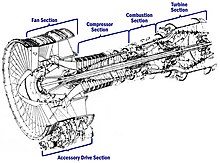General Electric CF6
The General Electric CF6, US military designations F103 and F138, is a family of high-bypass turbofan engines produced by GE Aviation.[3] GE quickly found interest in two designs being offered for a recent Eastern Airlines contract, the Lockheed L-1011 and the McDonnell Douglas DC-10.This would likely provide a range increase, and Volga-Dnepr Group operates 12 aircraft, implying a 50-60 engines with spares program.This initial version of the CF6 has a single-stage fan with one core booster stage, driven by a 5-stage LP (low pressure) turbine, turbocharging a 16-stage HP (high pressure) axial compressor driven by a 2-stage HP turbine; the combustor is annular; separate exhaust nozzles are used for the fan and core airflows.The basic CF6-50 engine was also offered with a 10% thrust derate for the 747SR, a short-range high-cycle version used by All Nippon Airways for domestic Japanese operations.The engine is designated the General Electric F103 in United States Air Force service on KC-10 Extenders and Boeing E-4s.[9] The industrial and marine development of the CF6-80C2, the LM6000 Series, has found wide use including fast ferry and high speed cargo ship applications, as well as in power generation.[10] In 2023, Bloomberg reported that European aviation regulators had determined that London-based AOG Technics, majority owned by Jose Zamora Yrala, whose nationality is listed as British on some forms and Venezuelan on others, supplied parts of unknown origin and false documents for repairs on CF6's.[11] In 1973, a CF6-6 fan assembly disintegrated, resulting in the loss of cabin pressurization of National Airlines Flight 27 over New Mexico, United States.[12] In 1979 a CF6-6 engine detached from the left wing of American Airlines Flight 191 due to faulty pylon maintenance, severing hydraulic lines and causing the aircraft to crash.[13] Following a series of high-pressure turbine failures on 6 September 1997,[14] 7 June 2000[15] and 8 December 2002,[16] and resulting in 767s being written off on 22 September 2000,[17] on 2 June 2006,[18] and on 28 October 2016,[19] the Federal Aviation Administration issued an airworthiness directive mandating inspections for over 600 engines and the NTSB believed that this number should be increased to include all -80 series engines with more than 3000 cycles since new or since last inspection.





Glenn Research CenterTurbofanGE AviationAirbus A300Airbus A330Boeing 747Boeing 767Lockheed C-5M Super GalaxyMcDonnell Douglas DC-10McDonnell Douglas MD-11Kawasaki C-2General Electric TF39General Electric LM2500General Electric LM6000high-bypass turbofan enginesLM2500LM6000turboshaftsC-5 GalaxyEastern AirlinesLockheed L-1011Rolls-Royce RB211Lockheed C-5M Galaxyexpress deliveryair cargoBoeingAirbus A330 MRTTreenginingProgress D-18Antonov An-124CargoLogicAirVolga-DneprsparesMcDonnell DouglasDC-10-10axial compressorcombustoroverall pressure ratioturboshaftDC-10-30Air FranceBoeing YC-14United States Air ForceKC-10 ExtendersBoeing E-4sNational Air and Space MuseumAirbus A310widebody aircraftBoeing 747-400ETOPS-180KC-767A/JE-767JVC-25ALockheed Martin C-5M Super GalaxyRolls-Royce Trent 700Pratt & Whitney PW4000LM6000 SeriesBloombergAirbus BelugaAirbus A310 MRTTAirbus CC-150 PolarisEADS/Northrop Grumman KC-45KC-767cabin pressurizationNational Airlines Flight 27New MexicoAmerican Airlines Flight 191United Airlines Flight 232Sioux City, IowaNational Transportation Safety Boardon 28 October 2016Federal Aviation AdministrationCompressorTurbinethrustPressure ratioBypass ratioDC-10-15/30KC-10A747-400Boeing KC-767A330 MRTTThrust-to-weight ratioIvchenko-Progress D-18Pratt & Whitney JT9DPratt & Whitney PW2000List of aircraft enginesGE Aerospaceaircraft enginesTurbojetsGE4/J5TurbofansAffinityCFE738CJ805-23GP7000PassportF404/F412TurbopropsCatalystH-SeriesAeroderivative gasturbine enginesLM1500LM1600LM9000LMS100PropfansUnited States militarydesignation systemvariantsLHTEC T800APW T800Adaptive cycle engines